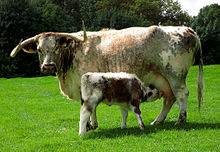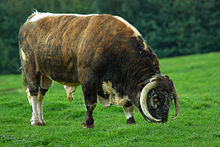English longhorn
English Longhorn or British Longhorn (English longhorn cattle, historically the cattle was also called Dishley, Leicestershire, Lancashire or Warwickshire cattle) is a now rare white-brown domestic cattle breed from Great Britain whose characteristics include the long, curved horns that frame the face.
English Longhorn cattle are almost exclusively kept in Great Britain. At the beginning of the 21st century there were 1,800 breeding animals in approximately 150 herds. The breed is listed as Endangered on the UK Rare Breeds Survival Trust's watch list.
features
The English Longhorn is a medium-sized cattle with a coat color ranging from dark brown to rusty red to light red. There are also brindle or red mold individuals. The racial characteristic is a white stripe on the back and belly and a white tail. It is desirable that the cattle also have a white spot on their thighs. Undesired breed characteristics are claws or horns with black coloring and animals without red in their fur.
The height at the withers of bulls, which can weigh up to 1000 kilograms, is 145 to 150 centimeters. The cows reach a height of 130 to 140 centimeters at the withers and weigh between 500 and 600 kilograms. The back is straight in both sexes, the hindquarter is strong. The horns are long and slender and point downwards in most animals. The fur is thick and silky.
English Longhorn is a robust and undemanding breed of cattle with a good-natured temperament. Their fertility is high, they calve easily and have good maternal traits. The calves are growing well.
The breed is suitable for extensive suckler cow husbandry and delivers a finely marbled meat without fat.
history
The English Longhorn is originally from the north and center of England and Ireland. This breed of cattle gained its importance when the influential British farmer and rancher Robert Bakewell began targeted breeding with this breed in the mid-18th century. Bakewell crossed long-horned cows of the original three-purpose breed , which were characterized by a strong hindquarter and quick attainment of physical maturity, with Westmoreland bulls, creating a breed that was distinguished by its high meat production. The breeding improvement of this breed coincides with a period in which, due to the beginning of industrialization, an ever increasing part of the British population lived in cities and the demand for meat increased. The English Longhorn is accordingly one of the early mast breeds. Even by today's standards, the English Longhorn beef is considered a breed with a favorable meat-to-bone ratio and a high degree of cannibalization . Bulls reach an average weight of 475 kilograms at an age of 400 days.
Due to the breeding improvement that Bakewell was able to achieve, the English Longhorn was the most frequently kept breed of cattle in England and Ireland at the turn of the 19th century. In terms of its importance, it was only replaced by short-horned cattle breeds in the early 19th century. The number of animals kept then steadily decreased. The first breed association called The Longhorn Cattle Society was founded in 1878 , but in 1950 the breed was only kept in a few farms. The breed is preserved today through efforts by the Rare Breeds Survival Trust .
Today's breeding
In Great Britain , the Longhorn cattle society keeps the herdbook for the breed. From 1982 to 2009 animals that did not have a definite proof of parentage were also included in main section A. Since then, it has been an open herdbook in which animals with a father who has been licensed by the association, with unsecured descent and pronounced breed characteristics, are transferred to department A after three generations via departments B and C with a blood percentage of 87.5%.
Bulls for breeding use must weigh at least 431 kg with an age of 400 days, have reached at least 631 kg with 600 days and a weight of at least 731 kg with an age of 800 days. Animals with imperfect horns and black horns or claws are not included in the herdbook. The other established breed characteristics are based on older descriptions.
Today's breeding goal is compliance with the described breed characteristics. In particular, deviations in the fur, horn and claw color result in deductions in the type assessment. Likewise, udders that are too low with non-absorbent teats. An English Longhorn cow is supposed to raise a healthy calf every year.
In 2013 there were a total of 13,663 registered animals in the UK.
In Germany, herd books from Fleischrinder Herdbuch Bonn e. V. and run by the Rinderzuchtverband Berlin-Brandenburg eG as recognized breeding associations. In 2015, no live animals of the breed were registered with either breeding organization.
Difference to the Texas Longhorn
Similar to the English Longhorn, the Texas Longhorn also has impressively long horns. However, the two breeds are not closely related to each other and also differ in that the horns of the Texas Longhorn are wide and can have a very wide range, especially in older oxen. The breed of the Texas Longhorn, which is smaller and lighter overall than the English Longhorn, goes back to cattle that were brought by the Spaniards via Mexico to what is now the USA in the 16th century. As tough, undemanding and resilient animals that can cope with very arid regions, the Texas Longhorns had their greatest economic importance in the two decades after the end of the American Civil War , when these cattle were raised in the southwest of the USA and used by cowboys for slaughter in the northeastern US.
literature
- Hans Hinrich Sambraus: Color Atlas of Farm Animal Breeds: 250 breeds in words and pictures . Eugen Ulmer Verlag, Stuttgart 2001, ISBN 3-8001-3219-2 .
Web links
- Longhorn Cattle Society page
- New Zealand rare breeds
- The Cattle Site
- University of Oklahoma, Department of Animal Science
Single receipts
- ↑ a b c d University of Oklahoma, Department of Animal Science , accessed May 25, 2015
- ↑ a b c d Hans Hinrich Sambraus: Color Atlas of farm animal breeds: 250 breeds in words and pictures . P. 85.
- ↑ Rare Breeds Survival Trust watchlist ( memento of the original from September 7, 2012 in the web archive archive.today ) Info: The archive link was automatically inserted and not yet checked. Please check the original and archive link according to the instructions and then remove this notice. , accessed June 7, 2015
- ↑ a b c Breed description on fleischrinderzucht.de
- ↑ a b c Longhorn cattle society: The herdbook of pure-bred longhorn-cattle (pdf) , accessed on May 29, 2015
- ↑ Breeding goal on fleischrinderzucht.de (pdf)
- ↑ Breed description at the Central Documentation of Animal Genetic Resources in Germany
- ↑ Supervised breeds of the beef cattle Herdbook Bonn ( Memento of the original from August 13, 2015 in the Internet Archive ) Info: The archive link has been inserted automatically and has not yet been checked. Please check the original and archive link according to the instructions and then remove this notice. (accessed on June 9, 2015)
- ↑ Supervised breeds of the Rinderzuchtverband Berlin-Brandenburg ( Memento of the original from June 20, 2015 in the Internet Archive ) Info: The archive link was inserted automatically and has not yet been checked. Please check the original and archive link according to the instructions and then remove this notice. (accessed on June 9, 2015)
- ^ Emily Jane McTavish: New World cattle show ancestry from multiple independent domestication events. In: PNAS. 2013.
- ↑ Hans Hinrich Sambraus: color atlas of farm animal breeds . P. 90





